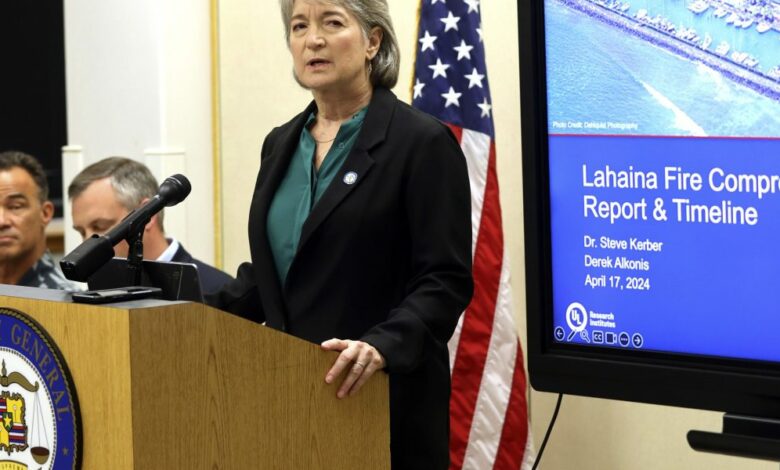Wildfire that caused $5.5 billion in damage ripped through Maui at a rate of a mile per 90 minutes


As unpredictable wildfires roared across Maui last August, the head of the emergency management agency dragged his heels about returning to the island amid the unfolding crisis, while a broad communications breakdown left authorities in the dark and residents without emergency alerts, according to a report released Wednesday.
Communications problems were also encountered with the Hawaiian Electric Company, with power and emergency workers unable to confirm that power lines were de-energized until well after flames had caused widespread damage, the report from the Hawaii Attorney General’s office said.
It was the second of two major assessments out this week about the deadliest U.S. wildfire in a century. A report released Tuesday by the Western Fire Chiefs Association detailed the challenges facing the Maui Fire Department during the unprecedented series of blazes, including one that killed 101 people in the historic town of Lahaina.
Attorney General Anne Lopez presented the latest report along with Steve Kerber, vice president of the Fire Safety Research Institute.
“When Attorney General Lopez contacted us, clearly we were paying a lot of attention to what was going on in Lahaina and really had the same question that she had. How is it possible that something like this could happen?” Kerber said.
Officials did not answer questions about cause or liability, saying it is only an initial reckoning and two more reports will follow. Investigators are still trying to get some documents from Maui County, officials said.
“We’re going to continue this investigation, and we will follow it wherever it leads,” Lopez said.
The federal Bureau of Alcohol, Tobacco, Firearms and Explosives is also investigating, and its report, expected to pinpoint cause, will come out before the one-year anniversary.
The report released Wednesday says that five days before the flames broke out, meteorologists warned that strengthening winds resulting from a hurricane south of Hawaii could lead to extreme wildfire risk Aug. 8. “Confidence in the development of critical fire weather conditions this many days away is quite rare, and we believe that this warrants a heads up to you,” a National Weather Service forecaster said in an email to fire contacts Aug. 3.
Kerber described complex and “incredibly fast” fires with flames traveling at a rate of about a mile in 90 minutes.
The Maui Emergency Management Agency had posted to Facebook on Aug. 6 about a “serious fire and damaging wind threat” due to dry conditions as Hurricane Dora passed.
The agency’s administrator, Herman Andaya, was off island at a conference on Oahu on Aug. 8 as the fires intensified. His call and text records show that he was getting updates from Gaye Gabuat, an administrative assistant. After a series of evacuations in Lahaina, Gabuat told Andaya that “multiple people look overwhelmed,” according to the report. Andaya asked if he should come home, to which Gabuat responded, “it may look okay.“
After the fire had been burning for more than five hours, Gabuat told Andaya that flames had reached Front Street, Lahaina’s commercial heart. Only then did Andaya respond that he had “better come home tomorrow.”
By that time multiple areas had been evacuated, according to a situation report by Andaya’s agency. Front Street had been closed along with the Lahaina bypass road, another key thoroughfare. In Lahaina alone, 29 utility poles were reported downed.
There was no immediate response to attempts Wednesday to reach Andaya, who resigned Aug. 18, via phone, email and social media.
Investigators said they requested incident activity logs and other records from the agency’s emergency operations center, or EOC, on multiple occasions. Derek Alkonis, a manager with the fire research institute, said they had received some information but not everything they had requested. “You’ll find in the report that there is a difficulty with gaining information from the EOC,” Alkonis said. “In terms of the reason for that challenge, it’s going to be analyzed in subsequent reports.”
The report also describes a breakdown in communication between police, firefighters and emergency officials after cell networks went down. Police and firefighters had to communicate using their handheld or car radios on closed channels that public officials and others could not listen to.
Meanwhile a stretched and limited dispatch center had single operators monitoring five or six channels at a time to keep up.
“With no cellular communication, residents and tourists were not able to receive emergency alerts, communicate with loved ones and/or to receive incoming or outgoing calls/texts,” the report’s authors wrote.
They detailed how one police officer told other responders his daughter had been babysitting in a neighborhood that was hit by the fire. Without cell communications he had no way to check if she escaped, and it took two days before he confirmed she was OK.
Fire crews also became trapped, according to staffing logs included in the report. Around 4:30 p.m., one engine was destroyed and another broke down. A firefighter from one of the engines rescued the crews using a police department SUV, according to the logs.
Hawaiian Electric has acknowledged that a downed power line sparked a fire in Lahaina early on the morning of Aug. 8. Firefighters were still mopping up that fire at noon and waiting for a utility worker to arrive and confirm that the power lines had been de-energized. But when the worker got there, he was unable to confirm the power had been cut off — information that would likely have helped fire crews assess the risk of re-ignition as well as the risk posed by other downed lines.
Still, the fire crew determined that the blaze was extinguished and headed back to the station at 2:17 p.m. By 2:55 p.m., several calls came about another fire in the same area. Firefighters were finally advised that power to the area had been shut off at 4:11 p.m., according to the report.
In the months since, Hawaiian Electric has said the lines were shut off for more than six hours before the afternoon fire was reported.
The attorney general’s report is the first phase of a comprehensive assessment that includes a timeline of the Lahaina fire using social media posts, metadata from citizen photos and videos, dispatch records, emergency communications and other sources. It describes the 72 hours before, during and after the blaze, and says investigators relied on “all known available facts” related to the fire and to preparations by local, state and federal agencies.
Because power was out to much of the area, security camera video generally wasn’t available, so investigators had to rely on interviews with residents and first responders to piece together the events.
“What this report doesn’t capture is the loss, the people, the challenges that they’ve gone through, the pain, the sorrow. And some of those things will be analyzed later. But you need the facts first,” Alkonis said.
Phase 2 of the report will focus on how Maui’s fire protection system functioned, specifically what conditions fed the inferno, attempts to stop its spread, and evacuations. The third phase will try to answer the critical question, “How do we prevent this from happening again?”
“The tragedy serves as a sobering reminder that the threat of grassland fires, wildfires, and wildfire-initiated urban conflagrations, fueled by climate change and urban encroachment into wildland areas, is a reality that must be addressed with the utmost urgency and diligence — not just in Hawaii, but around the globe,” the authors wrote.
The fire destroyed roughly 3,000 properties in Lahaina and caused more than $5.5 billion in estimated damage, according to state officials.
Source link




